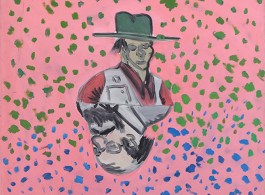LIDL Works and Performances from the 60s
Michael Werner Gallery, London, is pleased to present Jörg Immendorff: LIDL Works and Performances from the 60s, the first major exhibition dedicated to Immendorff in London in twenty years. Immendorff is among the most important artists to emerge during the post-war period in Germany. Featuring more than thirty paintings and objects, and augmented by a selection of rare documentary material, LIDL Works and Performances from the 60s presents an in-depth look at the development of one of twentieth century German art’s most dynamic figures.
Jörg Immendorff began his formal artistic training at the renowned Kunstakademie Düsseldorf during a time when that city was developing into an international centre for contemporary art. In 1964 Immendorff was admitted into the class of Joseph Beuys, then the most important artist working in Germany and a figure of profound influence for an entire generation of German artists. Immendorff’s relationship with Beuys marked the beginning of an intensely productive period for the young artist, who was deeply affected by the Beuysian notion that art can and should play a wider role in society. Immendorff initiated groundbreaking work immediately upon his entry into the Beuys class, creating objects and actions which challenged the traditions of fine art and which increasingly came to address the pressing social and political issues of the day.
LIDL Works and Performances from the 60s illuminates Immendorff’s formative years by focusing on the works and actions which he called LIDL. This phonetic invention, meant to mimic the sound of a baby’s rattle, was Immendorff’s DADA-like contribution to the revolutionary fervor of the 1960s. Immendorff, like many students of the time, was fiercely opposed to the war in Vietnam and he began his LIDL activities as a series of specific actions spurred largely by anti-war sentiment. LIDL Works and Performances from the 60s presents the seminal objects and performative works from Immendorff’s most visible LIDL actions, including “Vietnam. Vietnam. Vietnam.” and “The only respectable weapon” (both 1966). The exhibition also examines Immendorff’s application of the LIDL concept to challenge political institutions domestically, as with his formation of an independent “LIDL-Academy” within the Kunstakademie Düsseldorf (1968) and the attempted addition of a “LIDL room” to the parliamentary in Bonn (1969). These events, and the paintings and objects related to them, are important works in the context of their turbulent time and outline the trajectory of Immendorff’s subsequent work, which henceforth was concerned with the role of the individual in contemporary society and within history at large.
Complimenting these important early works is a selection of paintings Immendorff created at the end of his life. The artist’s long battle with the degenerative neurological disease ALS left him largely unable to paint in any conventional manner. Undeterred by his handicap, Immendorff continued to work with great intensity. He experimented with various alternative methods of image-making, including stamping, stenciling, monotype and offset, the use of assistants and contributions from the hands of his fellow artists. Further, Immendorff digitally manipulated imagery from his own works and from contemporary news photography. Images of death and war intermingle with passages of abstraction and pictures taken from the whole of art history, including the artist’s own past. Time and again in his last paintings Immendorff revisits Hogarth’s The Rake’s Progress. This eighteenth century cycle of paintings and engravings had been the departure point for a massive body of work Immendorff created during the mid-1990s at a time when he considered a commission to design settings for Stravinsky’s opera based on the Hogarth pictures. Immendorff’s take on Hogarth became highly personalised, featuring important figures such as Joseph Beuys and A.R. Penck – and Immendorff himself, among others – enacting roles in the story. Paintings from this first Rake’s Progress series were shown at the Barbican Art Gallery in 1995. Revisiting Hogarth at the end of his life, Immendorff intensified the allegory of the Rake’s demise by injecting his own personal tragedy into the story to create powerful meditations on mortality, conflict and the tragic folly of contemporary life.
Since the mid-1960s Immendorff exhibited throughout his native Germany. He participated in Documenta V in 1972, was included in the Venice Biennial in 1976, and from that time gained further exposure throughout Europe and internationally. Important exhibitions include Museum Boymans-van Beuningen, Rotterdam; Municipal Museum, The Hague; Museo Rufino Tamayo, Mexico City; Kunstmuseum, Bonn; Kunsthalle Düsseldorf; Neue Nationalgalerie, Berlin; and Van Abbemuseum, Eindhoven, among many others. In 2007 Museum Kunst Palast, Düsseldorf organised a sweeping survey of the artist’s drawings. In 1998 Immendorff was awarded the highly distinguished Order of Merit from the Federal Republic of Germany. Immendorff lived and worked in Düsseldorf and Hamburg until his death in 2007.



